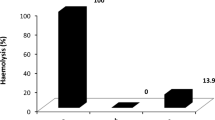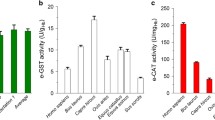Abstract
Methyl chloride is enzymatically conjugated with glutathione in human erythrocytes; the S-methyl glutathione thus formed is not released by the cells (Redford-Ellis et al 1971). S-methyl cysteine, the metabolic product of methyl chloride, is excreted in the urine of workers exposed to the substance (van Doom et al 1980).
Access this chapter
Tax calculation will be finalised at checkout
Purchases are for personal use only
Preview
Unable to display preview. Download preview PDF.
Similar content being viewed by others
References
Doom R van, Borm PJA, Leijdekkers Ch-M, Henderson PTh, Reuvers J, Bergen TJ van (1980) Detection and identification of S-methyl cysteine in urine of workers exposed to methyl chloride. Int Arch Occup Environ Health 46: 99–109
Guthenberg C, Mannervik B (1981) Glutathione S-transferase (transferase π) from human placenta is identical or closely related to glutathione S-transferase (transferase ρ) from erythrocytes. Biochem Biophys Acta 661: 255–260
Hussey AJ, Hayes JD, Beckett GJ (1987) Measurement of human neutral glutathione S-transferase (GST) concentration in plasma and biopsy tissue using radioimmunoassay, in: Glutathione S-transferases and carcinogenesis (TJ Mantle, CB Pickett, JD Hayes eds), Taylor & Francis, London, N. Y. and Philadelphia, pp 39–40
Marcus CJ, Habig WH, Jacoby WB (1978) Glutathione transferase from human erythrocytes. Arch Biochem Biophys 188: 287–293
Redford-Ellis M, Gowenlock AH (1971) Studies on the reaction of chloromethane with human blood. Acta Pharmacol et Toxicol 30: 36–48
Stewart RD, Hake CL, Wu A, Graff SA, Forster HV, Keeler WH, Lebrun AJ, Newton PE, Soto RJ (1977) Methyl chloride: Development of a biologic standard for the industrial worker by breath analysis. Report no NIOSH-MCOW-ENVM-MCM-77–1
Suzuki T, Coggan M, Shaw DC, Board PG (1987) Electrophoretic and immunological analysis of human glutathione S-transferase isoenzymes. Ann Hum Genet 51: 95–106
Warholm M, Guthenberg C, Mannervik B (1983) Molecular and catalytic properties of glutathione transferase μ from human liver: an enzyme efficiently conjugating epoxides. Biochemistry 22: 3610–3617
Author information
Authors and Affiliations
Editor information
Editors and Affiliations
Rights and permissions
Copyright information
© 1989 Springer-Verlag Berlin Heidelberg
About this paper
Cite this paper
Peter, H., Deutschmann, S., Muelle, A., Gansewendt, B., Bolt, M., Hallier, E. (1989). Different Affinity of Erythrocyte Glutathione-S-Transferase to Methyl Chloride in Humans. In: Chambers, P.L., Chambers, C.M., Greim, H. (eds) Biological Monitoring of Exposure and the Response at the Subcellular Level to Toxic Substances. Archives of Toxicology, vol 13. Springer, Berlin, Heidelberg. https://doi.org/10.1007/978-3-642-74117-3_17
Download citation
DOI: https://doi.org/10.1007/978-3-642-74117-3_17
Publisher Name: Springer, Berlin, Heidelberg
Print ISBN: 978-3-540-50336-1
Online ISBN: 978-3-642-74117-3
eBook Packages: Springer Book Archive




